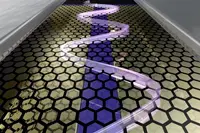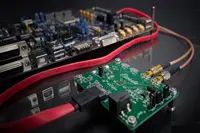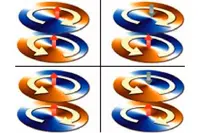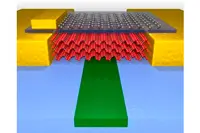Electronics News
Archive : 3 March 2015 год
 Physicists at the University of Basel, in conjunction with the Swiss Nanoscience Institute (SNI), have shown for the first time that electrons in graphene can be moved along a predefined path without loss.
Physicists at the University of Basel, in conjunction with the Swiss Nanoscience Institute (SNI), have shown for the first time that electrons in graphene can be moved along a predefined path without loss.
Scientists at the university have developed methods that allow them to stretch, examine and manipulate layers of pure graphene. In doing so, they discovered that electrons can move in pure graphene practically undisturbed. To lead the electrons from one specific place to another, they planned to actively guide the electrons along a predefined path in the material.
The mechanism applied is based on a property that occurs only in graphene. By combining electrical and magnetic fields, the electrons move along what the team calls a 'snake state'. The line bends to the right, then to the left, with the switch in direction due to the sequence of positive and negative mass. This phenomenon can only be realised in graphene and could be used as a novel switch.
"A nano switch of this type in graphene can be incorporated into a wide variety of devices and operated simply by altering the magnetic field or the electrical field," comments SNI Professor Christian Schönenberger.
Teams of physicists from Regensburg, Budapest and Grenoble were also involved in the study.
Author
Graham Pitcher
Source: www.newelectronics.co.uk
 Cambridge Consultants says it has successfully completed initial trials of a fully digital radio transmitter and says this could represent a turning point in wireless design.
Cambridge Consultants says it has successfully completed initial trials of a fully digital radio transmitter and says this could represent a turning point in wireless design.
Called Pizzicato, the digital radio transmitter consists of an IC, which outputs a single stream of bits, and an antenna. Algorithms perform the necessary computations in real time, making it possible for standard digital technology to generate high frequency radio signals directly.
"Our first trial of the technology has created 14 simultaneous cellular basestation signals," said Monty Barlow, director of wireless technology. "But it is the potential which is so exciting. Like mainstream microprocessing, a Pizzicato based radio would directly benefit from Moore's Law – shrinking in cost, size and power consumption with each new generation of silicon fabrication.
"It could also be programmed to generate almost any combination of signals at any carrier frequency, adapting its behaviour in a way that is impossible in conventional radios. It is early days for this technology, but we believe radio design has reached a turning point."
Author
Graham Pitcher
Source: www.newelectronics.co.uk
 Researchers at the Helmholtz-Zentrum Dresden-Rossendorf (HZDR), Forschungszentrum Jülich (FZJ) and CNRS have designed nanoscale components that not only store information within magnetic vortices, but also enable it to be read out reliably. Using this principle, the team claims, far more data could be stored in smaller memory chips.
Researchers at the Helmholtz-Zentrum Dresden-Rossendorf (HZDR), Forschungszentrum Jülich (FZJ) and CNRS have designed nanoscale components that not only store information within magnetic vortices, but also enable it to be read out reliably. Using this principle, the team claims, far more data could be stored in smaller memory chips.
Researchers at the Helmholtz-Zentrum Dresden-Rossendorf (HZDR), Forschungszentrum Jülich (FZJ) and CNRS have designed nanoscale components that not only store information within magnetic vortices, but also enable it to be read out reliably. Using this principle, the team claims, far more data could be stored in smaller memory chips.
The work is based on detecting the orientation of magnetic vortices in nanodisks electrically. In nanodisks – very thin and small disks of ferromagnetic material – electron spins are known to form magnetic vortices. The spins – and thus the magnetic moment of the electrons – are arranged as if ordinary bar magnets were lined up in a circle.
However, at the core of the nanodisk, the magnets are aligned out of the plane of the disk. "With these two properties – the sense of circulation of the in plane magnetisation and the magnetic orientation of the core –information can be stored," said Dr Attila Kákay, a former FZJ researcher, now at HZDR. "This means we can store as much as 2bit of information using a single vortex. Two vortices stacked on top of each other can store four memory bits, corresponding to 16 different states."
This type of magnetic nanopillar with two stacked vortices is 50nm high and 150nm in diameter – making it hard to read the information. "The magnetic orientation in the core could not be read reliably because the core was simply too small," said Dr Kákay. However, during the course of experiments at FZJ, the researchers found that alternating voltage signals are emitted by the stacked vortices when connected to a direct current. The characteristic frequencies of the microwaves are used to determine the core polarity and sense of circulation of the vortices.
Author
Graham Pitcher
Source: www.newelectronics.co.uk
 Continuing the recent trend to create and explore ultra thin molecular layers, researchers from the University of Minnesota have created a 20 atom thick film of black phosphorus and demonstrated it can support high speed data communication. The devices were said to have shown a 'vast improvement in efficiency' over comparable parts made from graphene.
Continuing the recent trend to create and explore ultra thin molecular layers, researchers from the University of Minnesota have created a 20 atom thick film of black phosphorus and demonstrated it can support high speed data communication. The devices were said to have shown a 'vast improvement in efficiency' over comparable parts made from graphene.
According to the team, it is only in the last year that black phosphorus' potential as a semiconductor been realised and added that it can be used to detect light.
"New two-dimensional materials continue to emerge with novel optoelectronic properties," said Professor Mo Li. "Because these materials are two dimensional, it makes perfect sense to place them on chips with flat optical integrated circuits to allow maximal interaction with light and use their novel properties optimally."
The team created optical circuits in silicon and then laid thin flakes of black phosphorus over these structures. This demonstrated that the performance of black phosphorus photodetectors rivals that of comparable devices made of germanium – considered the 'gold standard' in photodetection.
The researchers also sent optical data over fibres at up to 3Gbit/s and recovered it using black phosphorus photodetectors.
Because black phosphorus has a band gap that varies depending on how many layers are stacked together, it can be tuned to absorb light in the visible range but also in the infrared. And, because black phosphorus is a 'direct band' semiconductor, it has the potential to convert electrical signals back into light. This, says the team, could make it a 'one stop solution' for on chip optical communication.
Author
Graham Pitcher
Source: www.newelectronics.co.uk

